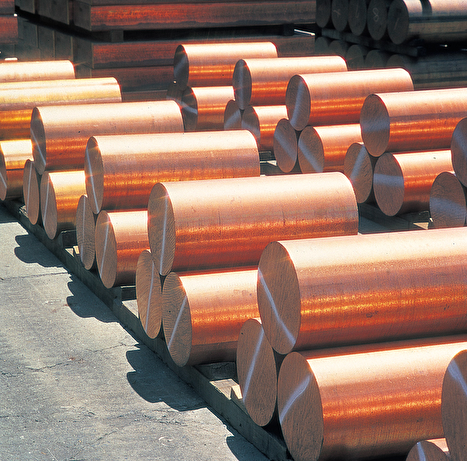Exactly how to Select the Right Copper Products for Your DIY Projects and Home Renovations
Exactly how to Select the Right Copper Products for Your DIY Projects and Home Renovations
Blog Article
Just How Copper Products Contribute to Lasting Practices in Various Markets
In eco-friendly power systems, for example, copper enhances the performance of solar and wind modern technologies, while its application in building minimizes waste via long life. As markets look for to take on more lasting techniques, the function of copper could verify pivotal in achieving environmental objectives.
Copper in Renewable Energy
Copper plays a critical duty in the advancement of renewable resource innovations, working as a crucial conductor in various applications. Its outstanding electric conductivity and resistance to deterioration make it an optimal product for electric circuitry, which is essential in photovoltaic panels, wind turbines, and energy storage systems. In solar photovoltaic systems, copper is made use of in the affiliations and wiring, making it possible for effective power conversion from sunshine to electrical power.
In wind energy, copper is essential to the generators and transformers that convert kinetic energy into electric power, making certain ideal performance and integrity. Additionally, the demand for electrical lorries (EVs) is boosting, with copper being an essential component in batteries, motors, and billing facilities. The change to EVs dramatically enhances the need for copper, as these lorries usually use four times extra copper than traditional internal combustion engine cars.
As the world seeks to alleviate climate change and transition to lasting energy resources, copper's function ends up being increasingly critical. The material not only boosts the effectiveness and resilience of sustainable power systems however additionally sustains the broader goal of minimizing greenhouse gas discharges and advertising a sustainable future.
Eco-Friendly Building And Construction Products
Over the last few years, there has been a noteworthy shift towards the adoption of environmentally friendly building materials in response to growing ecological issues. This change is motivated by the need for lasting options that lessen environmental footprints while preserving structural integrity and visual allure.
Copper, understood for its durability and recyclability, has become a principal in this industry. It can be used in roof, pipes, and electrical systems, adding to power performance and minimizing waste. Copper's longevity means less replacements over time, additional enhancing its sustainability account.
Furthermore, materials such as bamboo, redeemed timber, and recycled steel are gaining appeal. These alternatives not only use lowered environmental effect yet additionally promote resource preservation. As constructing codes increasingly stress sustainability, builders and designers are incorporating these materials into their tasks, fostering development in layout.
The raising fostering of environmentally friendly building and construction products shows a wider commitment to sustainability in the developed setting. By prioritizing these materials, the construction sector can dramatically decrease its carbon footprint, align with governing criteria, and sustain a healthier ecosystem for future generations. This fad marks a crucial action towards a much more sustainable future in building and construction.
Copper's Function in Health care
Current research studies have actually highlighted the significant role of copper in medical care setups, specifically due to its antimicrobial properties. Copper surfaces have actually been shown to minimize the presence of microorganisms, including bacteria and infections, by as much as 99.9% within a short duration. This remarkable efficacy makes copper an invaluable material for high-touch surface areas in health centers, such as doorknobs, bed rails, and IV posts, thus adding to enhanced infection control measures.
In enhancement to its straight antimicrobial impacts, copper additionally contributes in the broader context of medical facility sustainability (Copper Products). By including copper right into medical equipment and home furnishings, health care facilities can lower the incidence of healthcare-associated infections (HAIs), which not only improves individual outcomes however also lowers the expenses related to prolonged medical facility stays and added treatments
In addition, copper's toughness and recyclability straighten with sustainable practices, enabling accountable resource monitoring. As health care systems increasingly focus on both client safety and security and ecological stewardship, the combination of copper products is coming to be more common. This twin advantage underscores copper's important contribution to a much healthier, safer, and more sustainable medical care setting.
Sustainability in Transport

Moreover, copper's sturdiness and rust resistance add to the long life of transport facilities (Copper Products). In rail systems, as an example, copper elements enhance the dependability and performance of signaling and power systems, necessary for minimizing hold-ups and power consumption. In addition, copper's duty in renewable power systems, such as solar and wind, supports sustainable transportation services by providing tidy energy for electric transit options
Investments in copper modern technology not only foster sustainability however likewise boost economic development and job production in eco-friendly markets. As industries make every effort to meet stringent environmental guidelines, the application of copper products in transportation arises as a pivotal strategy in attaining sustainability goals and promoting a cleaner, a lot more reliable future.
Copper and Circular Economy
As the world progressively accepts sustainability, the duty of copper in the round economy comes to be ever much more significant. Copper's intrinsic residential or commercial properties-- such as its conductivity, resilience, and recyclability-- setting it as a key product in a resource-efficient economic situation. The circular economic climate aims to decrease waste and take full advantage of source usage with recycling and reusing materials, and copper master this respect.
The steel can be recycled forever without loss of quality, making it a suitable prospect for sustainable practices throughout numerous sectors, consisting of building and construction, electronics, and sustainable power. By recouping and reprocessing copper from end-of-life products, sectors can considerably decrease the demand for virgin products, therefore decreasing environmental influences connected with mining and handling.
Additionally, the integration of copper right into round economic situation frameworks not just conserves sources but likewise fosters technology. Companies that focus on copper recycling add to an extra sustainable supply chain, enhancing their competition while straightening with regulative demands and customer choices for environmentally liable items.
Conclusion
To blog conclude, copper items substantially contribute to lasting practices throughout several industries. Their necessary duty in improving renewable resource innovations, promoting environmentally friendly building and construction products, sustaining infection control in medical care, helping with lasting transport, and personifying the concepts of a circular economic climate highlights the adaptability and significance of copper. By integrating copper right into numerous applications, markets can accomplish greater efficiency, decrease environmental impact, and line up with international sustainability goals, ultimately cultivating an extra sustainable future.

Copper's excellent conductivity makes it a preferred product in electric automobile (EV) systems, enhancing power efficiency and performance. Furthermore, copper's role in eco-friendly power systems, such as solar and wind, supports sustainable transport remedies by offering tidy power for electrical transit choices.
Their essential duty in boosting visit site renewable energy modern technologies, advertising eco-friendly construction materials, supporting infection control in medical care, facilitating sustainable transportation, and symbolizing the principles of a round economic situation underscores the versatility and value of copper.
Report this page